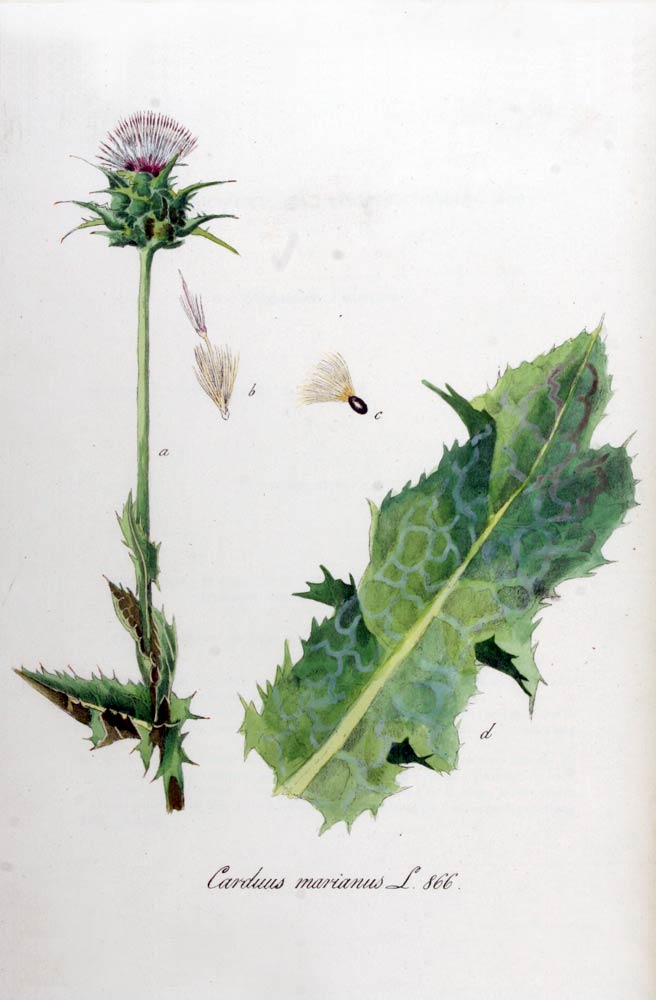Milk thistle seed powder
Milk thistle seed powder
Couldn't load pickup availability
milk thistle
Silybum marianum
Milk thistle is a Mediterranean plant in the daisy family that is characterized by tufts of purple flower heads surrounded by a halo of protective thorns. Because the plant is associated with the Virgin Mary, who is reputed to have wept over the plant, it is also called Holy Thistle, Blessed Thistle, Mary Thistle and Lady’s Thistle. The plant is harvested for its seed, which contains a significant amount of amino acids, protein and, most notably, a group of chemical compounds referred to as silymarin. Milk thistle seed can be added to salads and other foods, but is most commonly used to produce teas, infusions, tinctures and extracts.
a bit of botany
a little botanical information on milk thistle
description
Silybum marianum is an annual or biannual plant of the Asteraceae family. This plant can take on impressive proportions: it grows from 1 to 6 1/2 feet in height with its base at times reaching nearly 5 feet in diameter. Our wholesale milk thistle grows in a conical shape, the stem being grooved and somewhat cottony. In the larger specimens the stem is hollow.
Milk thistle's leaves are oblong to lanceolate— and they are either lobate or pinnate, with spiny edges. The leaves also have milk-white veins, are devoid of hair, and are shiny green.
The red-purple flower heads are 1 1/2 to 4 3/4 inches long and wide. They flower in the summer through autumn (more specifically from June to August in the North and from December to February in the Southern Hemisphere). Like its leaves, milk thistle's bracts are hairless, but have triangular, spine-edged appendages, that are tipped with a stout yellow spine.
The achenes (small, dry, one-seeded fruits) are black, with a simple long white pappus, surrounded by a yellow basal ring.
common names & nomenclature
Legend states that the milk-white veins of the leaves originated in the milk of the Virgin which once fell upon a plant of Thistle, hence it was called Our Lady's Thistle; the Latin name of the species has the same derivation.
Also known as:
Cardus marianus, milk thistle, blessed milk thistle, Marian Thistle, Mary Thistle, Saint Mary's Thistle, Mediterranean milk thistle,variegated thistle, Scotch thistle.
Not to be confused with Centaurea benedicta (aka Cnicus benedictus, aka Blessed Thistle)
Milk thistle is a member of the daisy or sunflower family and is characterized by tall erect stems with mottled, toothed alternative leaves that yield a milky liquid. The upper leaves support purple flower heads that are composed of tube-like florets surrounded by thorny spines. A hardy plant, milk thistle is commonly found growing along wayside paths and in pastures.
Milk thistle seeds contain up to 3% flavonolignans, primarily silybin A and B, a mixture referred to as silibinin. Other compounds include isosilybin A and B, silychristin and silydianin. These agents are together known as silymarin. The seeds also contain up to 30% fatty oil, vitamin E and the flavonoids apigenin, quercetin, taxifolin and naringenin.
Historically in ancient Rome and Greece this herb was used for liver disorders, but has also been grown by many cultures as a food. In Arab culture the young leaves are considered a delicacy and are added raw to salads. In medieval Europe all parts of the plant were eaten like a vegetable: the young roots were roasted; the peeled stems were braised or stewed; the spiny flower heads prepared like artichoke; and raw leaves (with stingers removed) were added to salad.
Nowadays the roots and peeled stems are still consumed as a vegetable often served after being boiled, while the base of the flower heads are cooked and eaten with melted butter (similar to familiar artichoke recipes). The seeds are also roasted and used as a coffee substitute.
Try sprinkling powdered milk thistle seeds into hot cereals, rice and vegetable dishes, either alone or in combination with sesame, sunflower, flax or other ground seeds. In terms of flavor, the Silybum marianum powder complements fish, soups and stews.
Share


